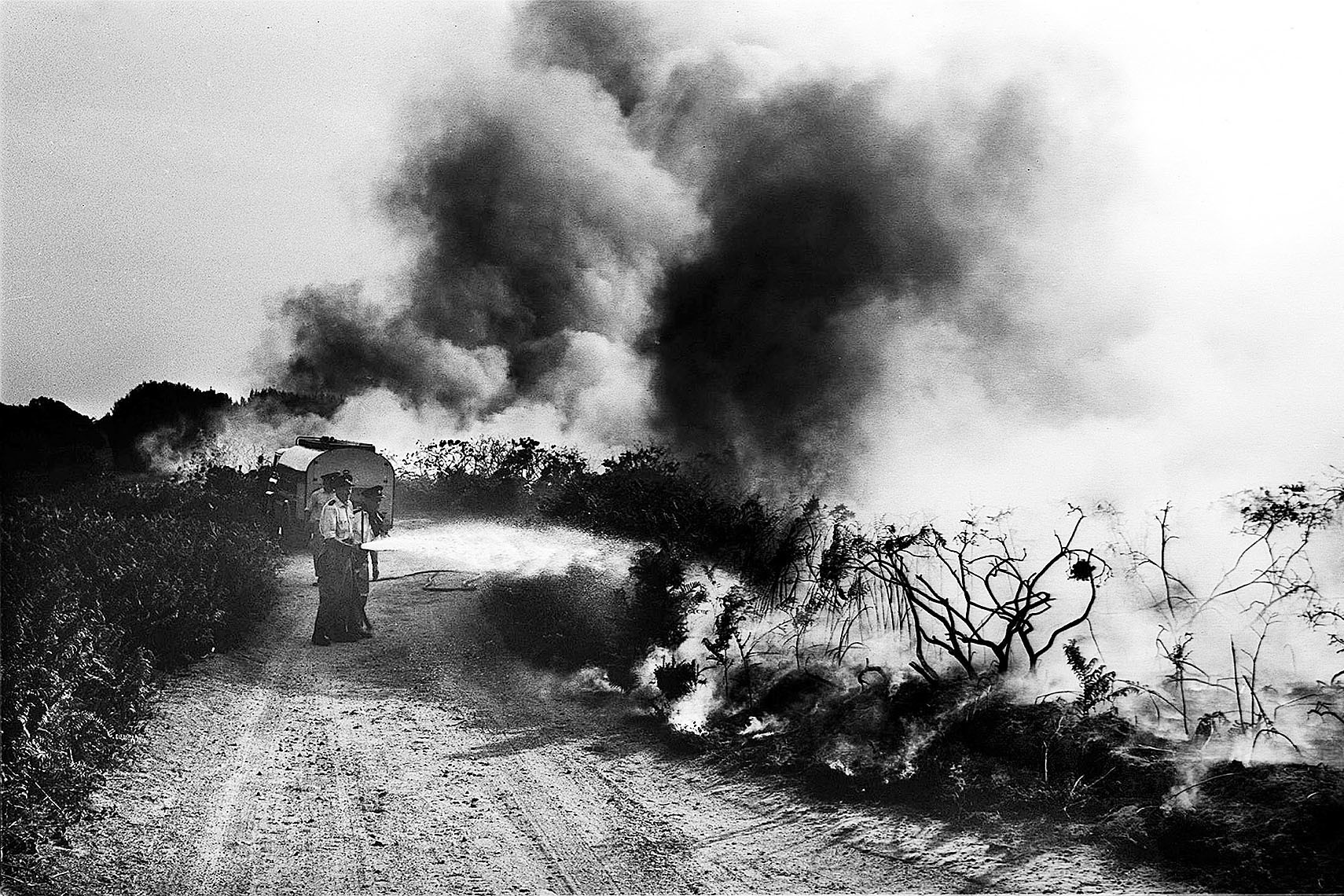IN August 1976, Jersey was at crisis point.
Following the driest winter on record and a barely interrupted heatwave since June, the Island’s precious water resources had become perilously scarce.
A campaign to save water launched by the Jersey New Waterworks Company, supported by the Jersey Evening Post, had not been enough to alleviate the plight. With the drought at its height, the States were left with no choice.
On 13 August a State of Emergency, signed by the Lieutenant-Governor, General Sir Desmond Fitzpatrick, at Government House, was declared.
‘With no desalination plant Jersey would be completely without water TODAY’ thundered the headline in that day’s edition of the JEP. All metered water consumers were informed of the allowance they were not to exceed for the next 28 days.
‘Any consumer who blatantly ignores the rationing will get cut off,’ said Rodney Clarke, of the waterworks company.
Illegal dams
Desperate farmers and growers with crops ruined by near-desert conditions were forced to use sewage for irrigation. A vegetable shortage loomed, milk had to be imported from England, bread rationing was threatened, and those who worked in industries reliant on water were faced with redundancy. Businesses had their water cut off, and some people, determined to preserve their ever-dwindling supply, constructed illegal dams – which only made matters worse.
The summer had begun happily enough, with Islanders and holidaymakers enjoying the spell of glorious weather. Met office reports showed that May was the sunniest on record. Despite a sticker campaign launched on 10 June to encourage people to save water, no one thought then that there would be no more rain, at least not a measurable amount, until September.
The drought became official on 14 June, but the waterworks company still confidently predicted that supplies would last until autumn and praised the public for their response to the water-saving appeal. ‘Consumers deserve ten out of ten for their co-operation,’ said engineer manager Dick Clarke.
There was even a light-hearted report in the JEP of the arrival of Doris Munday, Britain’s leading rainmaker, who claimed to have ended droughts in America, India, South Africa and China and had even made it rain in Britain for a week when she was ‘peeved’ with Harold Wilson.
Despite claiming responsibility for light drizzle the weekend before her arrival on 21 June, her touch seemed to desert her.
The drought continued, and five days later the hottest June day since records began was recorded when temperatures reached 32.9°C. (This record stood until 30 June 2015, when 33°C was reached and was broken again on 17 June this year when the mercury hit 33.2°C.)
Bathing pool
‘What a scorcher!’ ran one headline. But despite the holiday atmosphere, Islanders were now seeing signs of what was to come. The hot weather meant that UK tourists were staying at home. It spelled trouble for hotels and cabarets, but still the mood was upbeat.
‘The number of UK visitors for April and May was very much lower than last year, but with more continental visitors this doesn’t seem to be affecting the hotels too badly,’ said David Binnington, president of the Jersey Hotel and Guest House Association.
Some businesses, particularly those that sold chilled beers, soft drinks and ice-cream, even enjoyed a boom.
Havre des Pas bathing pool was full, giving the Jersey Swimming Club its highest-ever takings, and West Park Café served more than 6,000 customers in one weekend.
It was not all smiles, however. St Helier Girls School sports day had to be cancelled because they could not run in the heat and the Jersey Milk Marketing Board issued warnings to milk producers to ensure that their cooling equipment was in order.
As ‘flaming June’ turned into July, growers were getting desperate for rain, and nurserymen faced one of the worst seasons for years.
‘I don’t think that any growers will be able to make half the income of last year,’ warned Josef Racz, owner of the Strawberry Farm in St Peter.
Frustration with the drought led some farmers to construct dams on streams through their fields, illegally cutting off supplies to people further downstream.
Contrary to their optimistic mood only three weeks earlier, on 7 July the waterworks company conceded that their banked supplies were not enough.
‘I hope we can persuade the Island to save more voluntarily rather than to go through all the misery of rationing,’ said Mr Clarke. At that stage there was still three months’ supply in Jersey’s reservoirs, but the streams which fed them were drying up fast.

Waterworks Valley reservoir during the drought
Very serious
Consternation at those building dams without Island Development Committee permission was aggravated when it was discovered on 8 July that one of the illegal diggers was in fact a member of the IDC.
One dam in Trinity had completely stopped the flow of the stream, cutting off those on adjoining land to the extent that their landlord had to buy drinking water for them.
A week later the water shortages were described as a crisis, and an emergency meeting between senior politicians the Bailiff, Sir Frank Ereaut, and the waterworks company was called as stocks plummeted in the reservoirs.
The president of the Public Works Committee, Senator John Le Marquand, described the situation as ‘very, very serious’. ‘If the response to this appeal is not of a substantial order, then within a matter of just two or three weeks drastic measures will have to be taken,’ he warned.
As the crisis deepened, hotels appealed to holidaymakers not to waste Jersey’s precious water. ‘Suddenly it’s serious’ ran the headline in the JEP on 15 July, and letters to the editor blamed the tourism industry for making the bad situation worse.
‘A decade ago we had occasional shortages of water which necessitated the banning of hosepipes. This was before the commissioning of the last new reservoir and the desalination plant. Nevertheless we got through,’ wrote one angry reader. ‘Since then the resident population has increased fractionally, but accommodation for visitors has increased in leaps and bounds. Many of them have installed swimming pools and, as an immediate consequence, crops have suffered for want of irrigation and gardens have been devastated.’
Cauliflower growers were becoming particularly worried, while birds and wild plants were also suffering in the thirsty conditions. As water stocks fell by more than ten million gallons, borehole owners were warned that the waterworks company could not supply them when stocks ran dry.
Vegetable prices soared, and the waterworks company told the public on 21 July that consumption had to drop by 20%. Daily banner advertisements in the JEP told consumers that the Island must not exceed 2,850,000 gallons per day. ‘On July 29 we used 3,152,000’ the bold black lettering admonished.
Even the Battle of Flowers was affected, with many of the chrysanthemums for that year’s floats having to be brought in from the UK for the first time in Jersey’s history.
As the Island became more and more of a dustbowl, furze fires increased and the fire service was forced to use thousands of gallons of precious water to tackle each blaze, including one in St Mary which burned for more than 12 hours. Eventually the fire service turned to seawater.

Islanders collecting water from the fountain on Rue à Don in Grouville in August 1976
Recriminations
And they were not the only ones forced to find alternatives. On 7 July the JEP reported that the Resources Recovery Board plant at Bellozanne was supplying more than 100,000 gallons a day of treated effluent for farmers to use as irrigation.
As doom-laden warnings of water rationing increased, farmers were issued with a guide on water conservation by the Department of Agriculture, and local industries, equally reliant on water, talked of redundancies.
When water rationing started, so did the recriminations.
‘Unlawful dams waste more than rations will save’ ran the headline on 16 August. Restrictions on homes, businesses and schools forced a saving, but the waterworks company stressed that it was not enough.
Parish pumps were brought back into action, and with bread rationing threatened Bird’s Bakery in New Street dug out an Occupation recipe for baking bread with seawater, even turning out a few experimental loaves in case things got desperate.
Although bread rationing did not materialise, Islanders were still being warned on 24 August that they were not saving enough. As a farm at Mont à l’Abbé ran out of water completely, it looked as if farmer Eugene Le Coz was going to have to shoot his 42 cows.
Fortunately the slaughter was averted when the IDC granted him permission to dig a borehole two days later, but the mood in the countryside was grim. With near-desert conditions, Jersey’s fire chief, Bill Mahoney, warned that the Island’s furze and gorse was so dry that ‘it could ignite with almost explosive violence’.

The Island’s water shortage in the summer of 1976 posed no threat to Bird’s Bakery. Using a recipe drawn up in the Occupation, they baked bread with sea water. ‘While we have flour and yeast, we can bake enough to supply all our customers,’ said Cyril Bird, proprietor of the bakers in New Street
Battered by rain
A week later the first measurable rain fell, but it did not put an end to the Island’s woes. A cloudburst hit the north coast on 13 September, but this had no effect on Jersey’s water stocks. The rain came too late for the Island’s cauliflower growers, who thought that they would be lucky to produce even a third of their usual crop.
After the first month of rationing the waterworks company made good its earlier threat and businesses which over-consumed were cut off. Even the Freemasons were not spared – the Masonic Temple in Stopford Road lost its supply as a result of using double its allocation.
The JEP pursued offenders in its editorials, but the result of drought and overconsumption led to milk having to be imported from England on 28 September.
However, rain battered St Clement the following day, with cottages flooded and mud closing the Inner Road. At last it seemed that the end was in sight. Water rationing officially ended on 11 October: the State of Emergency was not renewed, and the desalination plant closed down. As a result, the IDC ordered that all dams constructed during the drought were to be emptied.
The crisis was over
But the repercussions were not. A debate had raged in the spring of 1975 over whether a 200-million-gallon reservoir should be built in Queen’s Valley. With the ending of the drought in 1976 that question was raised again.
The rest, as they say, is history.






